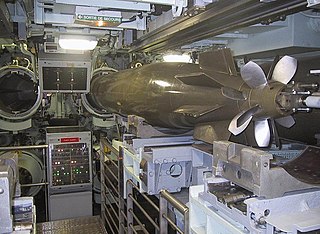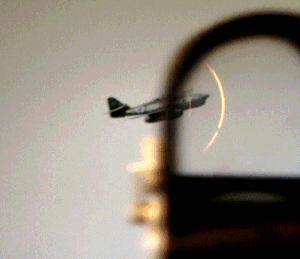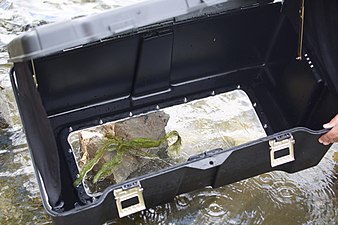
A kaleidoscope is an optical instrument with two or more reflecting surfaces tilted to each other at an angle, so that one or more objects on one end of these mirrors are shown as a regular symmetrical pattern when viewed from the other end, due to repeated reflection. These reflectors are usually enclosed in a tube, often containing on one end a cell with loose, colored pieces of glass or other transparent materials to be reflected into the viewed pattern. Rotation of the cell causes motion of the materials, resulting in an ever-changing view being presented.

A submarine is a watercraft capable of independent operation underwater. It differs from a submersible, which has more limited underwater capability. The term is also sometimes used historically or colloquially to refer to remotely operated vehicles and robots, as well as medium-sized or smaller vessels, such as the midget submarine and the wet sub. Submarines are referred to as boats rather than ships irrespective of their size.

A barometer is a scientific instrument that is used to measure air pressure in a certain environment. Pressure tendency can forecast short term changes in the weather. Many measurements of air pressure are used within surface weather analysis to help find surface troughs, pressure systems and frontal boundaries.

A torpedo tube is a cylindrical device for launching torpedoes.

The history of the telescope can be traced to before the invention of the earliest known telescope, which appeared in 1608 in the Netherlands, when a patent was submitted by Hans Lippershey, an eyeglass maker. Although Lippershey did not receive his patent, news of the invention soon spread across Europe. The design of these early refracting telescopes consisted of a convex objective lens and a concave eyepiece. Galileo improved on this design the following year and applied it to astronomy. In 1611, Johannes Kepler described how a far more useful telescope could be made with a convex objective lens and a convex eyepiece lens. By 1655, astronomers such as Christiaan Huygens were building powerful but unwieldy Keplerian telescopes with compound eyepieces.

A periscope is an instrument for observation over, around or through an object, obstacle or condition that prevents direct line-of-sight observation from an observer's current position.

A refracting telescope is a type of optical telescope that uses a lens as its objective to form an image. The refracting telescope design was originally used in spyglasses and astronomical telescopes but is also used for long-focus camera lenses. Although large refracting telescopes were very popular in the second half of the 19th century, for most research purposes, the refracting telescope has been superseded by the reflecting telescope, which allows larger apertures. A refractor's magnification is calculated by dividing the focal length of the objective lens by that of the eyepiece.

Cornelis Jacobszoon Drebbel was a Dutch engineer and inventor. He was the builder of the first operational submarine in 1620 and an innovator who contributed to the development of measurement and control systems, optics and chemistry.

An eyepiece, or ocular lens, is a type of lens that is attached to a variety of optical devices such as telescopes and microscopes. It is named because it is usually the lens that is closest to the eye when someone looks through an optical device to observe an object or sample. The objective lens or mirror collects light from an object or sample and brings it to focus creating an image of the object. The eyepiece is placed near the focal point of the objective to magnify this image to the eyes. The amount of magnification depends on the focal length of the eyepiece.

An atmospheric diving suit (ADS) is a small one-person articulated submersible which resembles a suit of armour, with elaborate pressure joints to allow articulation while maintaining an internal pressure of one atmosphere. An ADS can enable diving at depths of up to 700 metres (2,300 ft) for many hours by eliminating the majority of significant physiological dangers associated with deep diving. The occupant of an ADS does not need to decompress, and there is no need for special breathing gas mixtures, so there is little danger of decompression sickness or nitrogen narcosis when the ADS is functioning properly. An ADS can permit less skilled swimmers to complete deep dives, albeit at the expense of dexterity.

Borosilicate glass is a type of glass with silica and boron trioxide as the main glass-forming constituents. Borosilicate glasses are known for having very low coefficients of thermal expansion, making them more resistant to thermal shock than any other common glass. Such glass is subjected to less thermal stress and can withstand temperature differentials without fracturing of about 165 °C (300 °F). It is commonly used for the construction of reagent bottles and flasks, as well as lighting, electronics, and cookware.

The James Lick Telescope is a refracting telescope built in 1888. It has a lens 91 centimetres (36 in) in diameter—a major achievement in its day. The instrument remains in operation and public viewing is allowed on a limited basis. Also called the "Great Lick Refractor" or simply "Lick Refractor", it was the largest refracting telescope in the world until 1897 and now ranks third, after the 40-inch refractor at the Yerkes Observatory and the Swedish 1-m Solar Telescope. The telescope is located at the University of California's Lick Observatory atop Mount Hamilton at an elevation of 1,283 metres (4,209 ft) above sea level. The instrument is housed inside a dome that is powered by hydraulic systems that raise and lower the floor, rotate the dome and drive the clock mechanism to track the Earth's rotation. The original hydraulic arrangement still operates today, with the exception that the original wind-powered pumps that once filled the reservoirs have been replaced with electric pumps. James Lick is entombed below the floor of the observing room of the telescope.
The history of the submarine spans the entire history of human endeavor as mankind has since early civilization sought to explore and travel under the sea. Humanity has employed a variety of methods to travel underwater for exploration, recreation, research and significantly, warfare. While early attempts, such as those by Alexander the Great, were rudimentary, the advent of new propulsion systems, fuels, and sonar, propelled an increase in submarine technology. The introduction of the diesel engine, then the nuclear submarine, saw great expansion in submarine use – and specifically military use – during World War I, World War II, and the Cold War. The Second World War use of the U-Boat by the Kriegsmarine against the Royal Navy and commercial shipping, and the Cold War's use of submarines by the United States and Russia, helped solidify the submarine's place in popular culture. The latter conflicts also saw an increasing role for the military submarine as a tool of subterfuge, hidden warfare, and nuclear deterrent. The military use of submarines continues to this day, predominantly by North Korea, China, the United States and Russia.

Brandtaucher was a submersible designed by the Bavarian inventor and engineer Wilhelm Bauer and built by Schweffel & Howaldt in Kiel for Schleswig-Holstein's Flotilla in 1850. The Brandtaucher is the oldest known surviving submarine in the world.

HMS Oxley was an Odin-class submarine of the Royal Australian Navy (RAN) then Royal Navy (RN). Very slightly off course, near Obrestad, on the south-western cape of Norway, she was hit by friendly fire seven days after the start of World War II costing 53 lives and leaving two survivors.

A submarine snorkel is a device which allows a submarine to operate submerged while still taking in air from above the surface. British Royal Navy personnel often refer to it as the snort. A concept devised by Dutch engineers, it was widely used on German U-boats during the last year of World War II and known to them as a Schnorchel.

The paravane is a towed winged (hydrofoiled) underwater object—a water kite. Paravanes have been used in sport or commercial fishing, marine exploration and industry, sports and military applications. The wings of paravanes are sometimes in a fixed position, else positioned remotely or by actions of a human pilot. Pioneer parafoil developer Domina Jalbert considered water kites hardly different from air kites. However, paravanes generally orient themselves in respect to the water surface. They may have sensors that record or transmit data or be used entirely for generating a holding force like a sea anchor does. While a sea-anchor allows a vessel to drift more slowly downwind, the paravane travels sideways at several times the downwind speed. Paravanes are, like air kites, often symmetrical in one axis and travel in two directions, the change being effected by gybing, shunting, or flipping over.

A reflector sight or reflex sight is an optical sight that allows the user to look through a partially reflecting glass element and see an illuminated projection of an aiming point or some other image superimposed on the field of view. These sights work on the simple optical principle that anything at the focus of a lens or curved mirror will appear to be sitting in front of the viewer at infinity. Reflector sights employ some form of "reflector" to allow the viewer to see the infinity image and the field of view at the same time, either by bouncing the image created by lens off a slanted glass plate, or by using a mostly clear curved glass reflector that images the reticle while the viewer looks through the reflector. Since the reticle is at infinity it stays in alignment with the device to which the sight is attached regardless of the viewer's eye position, removing most of the parallax and other sighting errors found in simple sighting devices.

A dive light is a light source carried by an underwater diver to illuminate the underwater environment. Scuba divers generally carry self-contained lights, but surface supplied divers may carry lights powered by cable supply.
Sarah Mather was an American inventor, best remembered for patenting the first underwater telescope.






















